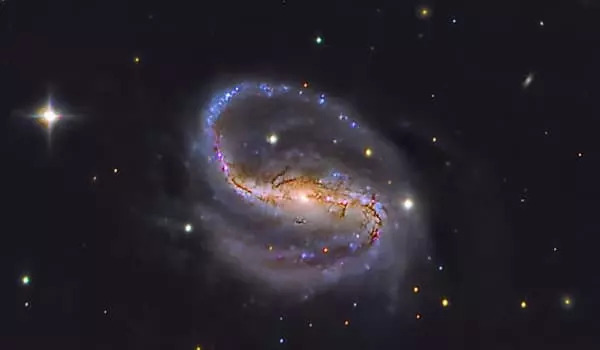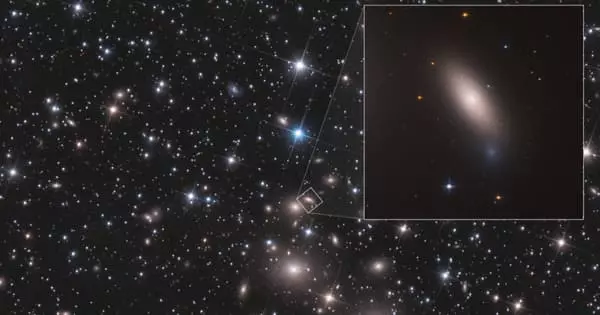Dark matter also makes its presence known through gravitational lensing. The dark matter halo of a nearby galaxy distorts the light from background galaxies into a ring of mirages around the closer galaxy. Dark Matter can be detected astronomically only by its gravitational effects on stars and gas: It makes the outer parts of galaxies rotate faster than expected from their starlight. It makes galaxies in clusters orbit faster than expected from the total starlight of the galaxies.
For 30 years, astrophysicists have predicted such a slowdown, but this is the first time it has been measured. The researchers say it gives a new type of insight into the nature of dark matter, which acts like a counterweight slowing the spin.
According to a new study by researchers at University College London (UCL) and the University of Oxford, the spin of the Milky Way’s galactic bar, which is made up of billions of clustered stars, has slowed by about a quarter since its formation.
Our galaxy has a massive bar of stars in the center from which its spiral arms emerge. That bar, like the rest of the galaxy, rotates, but the dark matter that pervades the Milky Way slows it down by about 13% every billion years.
Dark matter must be the counterweight slowing this spin. We could only infer dark matter until now by mapping the gravitational potential of galaxies and subtracting the contribution from visible matter. Our findings provide a new way to measure dark matter: its inertial mass, which slows the bar’s spin rather than its gravitational energy.
Rimpei Chiba
The study, published in the Monthly Notices of the Royal Astronomical Society, examined Gaia space telescope observations of a large group of stars known as the Hercules stream that are in resonance with the bar, meaning they revolve around the galaxy at the same rate as the bar’s spin.
The spinning bar has trapped these stars in its gravitational pull. The same thing happens with Jupiter’s Trojan and Greek asteroids, which orbit Jupiter’s Lagrange points (ahead and behind Jupiter). If the spin of the bar slows, these stars should move further out in the galaxy, keeping their orbital period in sync with the spin of the bar.
The researchers discovered that the stars in the stream have a chemical fingerprint: they are richer in heavier elements (called metals in astronomy), indicating that they have traveled away from the galactic center, where stars and star-forming gas are about ten times as rich in metals as the outer galaxy.
Using this information, the team calculated that the bar, which is made up of billions of stars and trillions of solar masses, had slowed its spin by at least 24 percent since its formation. “Astrophysicists have long suspected that the spinning bar at the center of our galaxy is slowing down, but we have found the first evidence of this happening,” said co-author Dr Ralph Schoenrich (UCL Physics & Astronomy).

“Dark matter must be the counterweight slowing this spin. We could only infer dark matter until now by mapping the gravitational potential of galaxies and subtracting the contribution from visible matter. Our findings provide a new way to measure dark matter: its inertial mass (the dynamical response), which slows the bar’s spin rather than its gravitational energy.”
Rimpei Chiba, co-author and PhD student at the University of Oxford, stated: “As different models change the inertial pull on the galactic bar, our discovery provides an intriguing perspective for constraining the nature of dark matter. Our discovery also poses a major problem for alternative gravity theories, as they predict no, or significantly too little, slowing of the bar due to a lack of dark matter in the halo.”
Like other galaxies, the Milky Way is thought to be surrounded by a halo of dark matter that extends far beyond its visible edge. Dark matter is invisible and unknown in its nature, but its existence is inferred from galaxies behaving as if they were shrouded in significantly more mass than we can see. The Universe is thought to contain approximately five times as much dark matter as ordinary, visible matter. Alternative gravity theories, such as modified Newtonian dynamics, reject the concept of dark matter in favor of explaining discrepancies by modifying Einstein’s theory of general relativity.
The Milky Way galaxy is a barred spiral galaxy, with a thick bar of stars in the center and spiral arms extending through the disc beyond the bar. The bar rotates in the same way that the galaxy does. The Royal Society, the Takenaka Scholarship Foundation, and the Science and Technology Facilities Council all provided funding for the study (STFC).
The motions of galaxies provide the most evidence for dark matter. Dark matter explains why stars far from the centers of rotating galaxies have much higher velocities than predicted by the visible matter distribution alone. The galaxies would collide if there was no additional matter exerting gravitational pull. To explain the “excess velocity” of stars, scientists believe dark matter forms a spherical halo around galaxies. Evidence for dark matter can also be found in galaxy clusters, which require far more matter than what is visible to generate the gravitational forces that hold the clusters together. Gravitational lensing also detects the presence of dark matter. A nearby galaxy’s dark matter halo distorts the light from background galaxies, forming a ring of mirages around the closer galaxy.





